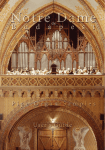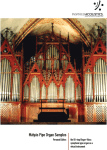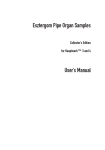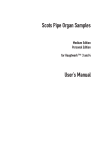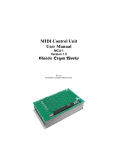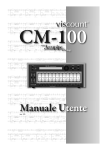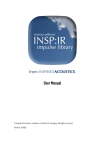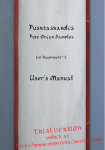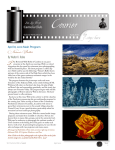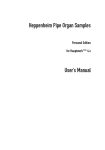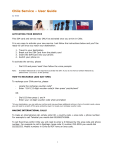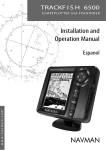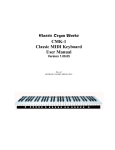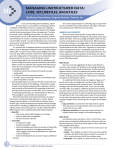Download Kispest Pipe Organ Samples User Manual
Transcript
© Inspired Acoustics, a division of Entel Ltd, Hungary. All rights reserved.
Printed in Hungary.
Version 2009|D
Kispest
Pipe Organ Samples
for Hauptwerk* 3
User’s Manual
Table of contents
1
2
Welcome
5
1.1
1.2
1.3
5
5
6
Highlights
What is contained inside the package
Hardware and software requirements
Installation
8
2.1
2.2
8
9
Installation of the main organ
Installation of upgrades, Extended Edition and updates
3
Organ Definition (ODF) files and their use
10
4
The real-time adjustable acoustic control
10
5
Controls of the virtual pipe organ
12
5.1
5.2
5.3
5.4
5.5
5.6
5.7
5.8
12
13
13
13
14
15
16
17
6
7
Pages
Keys and keyboards
Stops
Multipurpose LED display
Buttons
Foot pistons
Swellbox and crescendo wheel
Independent Combination Action
The Notre Dame of Kispest and its pipe organ
20
6.1
6.2
6.3
6.4
20
21
28
28
The Notre Dame of Kispest
The Kispest Organ
Disposition
Recording
Usage terms and conditions
29
7.1
7.2
29
31
End-user license agreement (EULA)
Trademarks
8
Partners and credits
32
9
Appendix - MIDI-assignable switches
33
Kispest Pipe Organ Samples
Welcome
5
1 Welcome
Welcome to the Kispest Pipe Organ Samples and congratulations
for your purchase!
Kispest Pipe Organ Samples (also known as Kispest Organ or
simply KO) is a fully playable, freely configurable, intuitively
manageable and MIDI-controllable virtual pipe organ, delivering
the authentic sound of the 38-stop Rieger-Varga pipe organ of
the Notre Dame of Kispest, Budapest, Hungary.
1.1
Highlights
The organ has many unique and special features, including:
•
•
•
•
•
‘Real-time acoustic setup’ to configure spatial and surround sound while you play
(see Chapter 0)
Fully functional Combination Action exactly duplicating the real organ, independent
of Hauptwerk*’s combination action, controllable directly from the screen or by
means of MIDI. (see Chapter 5.8)
Multistage programmable crescendo with multiple programs (see Chapter 5)
Multiple pages optimized for single or dual touch-screens. (see Chapter 5.1)
and more
1.2
What is contained inside the package
1.2.1
Contents of the box
If your version of Kispest Pipe Organ Samples was delivered to you in a physical form rather
than a download, please make sure you have the following contents in the box to ensure you
have received a complete product:
•
•
•
Delivery Medium – USB thumb drives (also known as USB sticks) containing the
installation data or an External Hard Disk Drive (i.e. with a USB connector)
Your personal serial number on a printed registration card (this may not be
necessary for a downloadable version)
Kispest Pipe Organ’s User’s Manual (this document)
Kispest Pipe Organ Samples
Hardware and software requirements
1.3
6
Hardware and software requirements
Kispest Pipe Organ Samples is hosted within Hauptwerk* virtual pipe organ software,
available for both PC and Mac computers from Milan Digital Audio, found at
http://www.hauptwerk.com on the Internet. Hauptwerk* functions with both currently
available 32-bit and 64-bit operating systems. Hauptwerk* Advanced Edition is
recommended. A high-performance computer is required to experience full, flawless and
convenient operation of this library.
1.3.1
RAM and number of loadable stops
Since Hauptwerk* loads the sample data into the computer’s random access memory (RAM)
– and does not stream data from the hard disk – the amount of RAM determines the number
of stops you can load for playing at a given time. The theoretical RAM limitation, per program
instance is 4 GB in 32-bit operating systems; loading all stops of the organ requires a 64-bit
operating system, capable of handling more than 4 GB of RAM. Regardless of operating
system, please make sure you are using more than 4 GB of RAM.
Hauptwerk* allows you to load the library with independent options for each available stop,
allowing you to trade off the number of loadable stops with varying degrees of realism (you
can, for example, choose to load less than the full complement of release samples). Loading
all of the stops in their most complete multi-looped versions and with full release samples
will consume much more RAM than loading them with, say, single looped data and/or
truncated release tails.
Please refer to the Hauptwerk* User’s Manual for a complete description of how to maximize
performance with these features.
Hauptwerk* offers lossless compression for sample loading. We recommend turning this
option ON when loading the samples, since it does not affect the quality of sound, but
increases the number of stops one can load at a time.
There are different organ definition files (see Chapter 3) with different features and capabilities.
The following table summarizes their loading requirements. Further data can be found on the
Inspired Acoustics website.
RAM requirements for Kispest Pipe Organ
ODF file
Loading setup
Bits
Stereo
Full organ, 38 stops 24
Full organ, 38 stops 16
Full organ, 38 stops 16
Multiple
Loops
Multiple
Releases
Subjective
Quality
Required RAM
all
all
maximum
12.95 GB
all
almost
maximum
6.97 GB
all
nearly
maximum
5.00 GB
all
first
Kispest Pipe Organ Samples
Hardware and software requirements
7
RAM requirements for Kispest Pipe Organ
Multiple
Loops
Multiple
Releases
Subjective
Quality
Full organ, 38 stops 16
first
all
maximum
10 GB
Full organ, 38 stops 24
first
all
maximum
8.7 GB
ODF file
Loading setup
Quad
Adjustable 2D
1.3.2
Bits
Required RAM
CPU and Polyphony
It is essential that your computer has a high-performance CPU in order to experience full
polyphony. A high polyphony capability is required when many stops are drawn and many
notes played together.
Note:
Polyphony is defined as the number of stops being selected, times the number of notes
held per stop, including the duration release tails to sound, at any given time.
A series of fast staccato chords in Tutti will stress your computer the most, because the initial
release tails will continue to sound as additional staccato chords are being played. For the
most flawless operation, we recommend the use of a 4-core CPU or better, equipped with the
most RAM that you can afford. As your CPU power increases, you can achieve more
polyphony.
Please refer to the Hauptwerk* User’s Manual for a complete description of how to achieve
maximum polyphony with your computer.
Kispest Pipe Organ Samples
Installation
8
2 Installation
2.1
Installation of the main organ
Installing the Kispest Pipe Organ Samples requires that you own an installed copy of Hauptwerk*
virtual pipe organ software.
This installation procedure is for Hauptwerk* version 3. If using a later version of Hauptwerk*, the
required steps may be slightly different in detail; please refer to your version’s copy of the
Hauptwerk* User Guide.
If you received the Kispest Pipe Organ Samples as a downloadable product, please make sure
that you downloaded all the installation files prior you begin installing. This is important because,
unlike previous sample sets, the Kispest Organ comes as a large multi-part installation package
split into a number of files to make the download easier. The split files will be automatically
handled by the installer, but the only requirement is to have all the files in one folder.
If you received a retail box product you will need to insert the installation medium first. If this is
an External Hard Disk Drive or a USB memory stick (pen drive) please insert it in your computer
and navigate to the device to see the folders and files.
Wait until the computer recognizes the USB drive and, either a drive letter is dispatched to it (PC
- Windows), or it is mounted on the desktop (Mac - OS X). Once your computer has accessed the
USB media, proceed to the next step.
1.
Launch Hauptwerk* virtual organ software.
2.
From within Hauptwerk*, go to the file menu and select Install organ, sample set,
temperament or impulse response.
3.
The program will prompt you to select the program to install.
4.
Navigate to the folder with the installation files and select the first file set to install.
5.
Click Open and then click OK on the next screen.
6.
Wait until Hauptwerk* finishes installing the file you have selected.
Ensure that you have the latest version of the packages installed and apply any updates or
upgrades that you have (see the next section to find out how).
Kispest Pipe Organ Samples
Installation
2.2
9
Upgrading or updating the Trial or the Professional Edition
Any updates and upgrades require the main organ data package to be installed first. All
upgrades, updates and the Extended Edition as well come as separate installer files, either single
or multi-part. Once you have all the files downloaded or received otherwise on your computer,
please install them. The procedure for installing upgrades and updates is the same as the normal
installation process, except that, instead of inserting a USB media, you may receive the update or
upgrade files by downloading them from the Inspired Acoustics website,
http://www.inspiredacoustics.com.
To obtain the latest updates you need to register your copy. To do this:
1.
Go to http://www.inspiredacoustics.com
2.
Create an account if you do not already have one by clicking on the Sign Up link.
3.
In case you received a boxed product click the Register menu and enter your serial
number that you received. If you do not have a serial number and you do not already
see the organ in the My Products section please contact us.
4.
After you registered go to the My Products section and you will find your product
and its Update files within a few minutes.
5.
Download the package that has the name ‘LATEST’ written in it. Install this package,
once downloaded, following the procedure above in Section 2.1.
For the smoothest operation, please ensure that you have the latest version of your
product, so please download and install this file once a new version becomes available. This file
is made so that it will update your organ to the latest version regardless of what version you
have. To see what is changed, you can find the latest version numbers and version history at the
same website and at the Inspired Acoustics Knowledge Base website
(http://www.inspiredacoustics.com/kb).
Kispest Pipe Organ Samples
Features and usage
10
3 Organ Definition (ODF) files and their use
There are different ODF files supplied with your Kispest Pipe Organ each coming with
different meaning and capabilities. The ODF names correspond to their meaning.
Organ Definition File
Functionality and sound
Kispest Pipe Organ Samples
Front stereo (relatively dry)
Kispest Pipe Organ Samples – Reduced
Front stereo (relatively dry), with only 2 release layers for
reduced RAM usage
Kispest Pipe Organ Samples – Surround
Fixed 4-channel (Quad / LRLsRs) surround
Kispest Pipe Organ Samples – Surround Reduced
Fixed 4-channel (Quad / LRLsRs) surround, with only 2
release layers for reduced RAM usage
Kispest Pipe Organ Samples – Adjustable 2D
(see Chapter 4)
Adjustable surround in 2 dimensions (3 vector channel
outputs)
Kispest Pipe Organ Samples – Adjustable 2D Reduced
(see Chapter 4)
Adjustable surround in 2 dimensions (3 vector channel
outputs), with only 2 release layers for reduced RAM usage
Tip:
you can use the 4-channel (quad) surround’s rear channels as a 2-channel stereo setup to
obtain a more distant, more wet fixed acoustic condition.
4 The real-time adjustable acoustic control
The Kispest organ is supplied with a real-time acoustic control feature that can be used with
the INSP:DEC Surround Customizer VST plugin. It has a different documentation also provided
with the Kispest Pipe Organ Samples, this section covers how to optimally set up Hauptwerk*
to make this feature work.
Kispest Pipe Organ Samples
Features and usage
11
To be able to use the real-time acoustic control Hauptwerk* should output 3 or 4
independent channels for each stop. There is a separate ODF file that supports this.
For a 2-dimensional full control, 3 channels are needed, for a 3-dimensional control 4
channels are required. 3-dimensional control is available in the Extended Edition of the
Kispest Pipe Organ Samples.
Please note that this feature works currently (as of Hauptwerk* version 3.23) only in Windows.
For Mac compatibility, please refer to updates on the Inspired Acoustics website.
The step-by-step configuration to allow the real-time acoustic spatial control is – as of
Hauptwerk* version 3 – as follows:
1.
Set up 3 or 4 independent Audio Output Groups in Hauptwerk*. To do this, go to
the General Settings menu and select Audio Output Groups. Here press Insert and
give a desired name to each output. Insert outputs so that 3 or 4 outputs will be
present (add 4 output groups if you use the Extended Edition of the Kispest Pipe
Organ Samples or 3 otherwise).
2.
Assign audio routing in Hauptwerk*. To do this, go to General Settings menu and
select Audio Outputs. Press Insert, give a name to this output and click the Routing
tab on the top right side. Here select one of the Audio output groups that you
Kispest Pipe Organ Samples
Features and usage
12
have created in the previous step. Repeat this step for each audio output groups
so that all of them will be assigned to a different Audio Output that you can create
here.
3.
Load the appropriate ODF file of the Kispest Organ and route each output in their
coming order. To do this: select all ranks that are named starting ‘Base:’ and select
the destination output group on the right side to your first output that you created
in the previous step. Assign ranks named ‘Depth’ and ‘Width’ the same way to the
other two different outputs. If you have the Extended Edition, assign ‘Height’ to
the fourth output group.
4.
Wire the loaded organ into the VST Plugin. Load the organ and then connect the
outputs of Hauptwerk* to the inputs of the Surround Customizer VST Plugin. To do
this please refer to your audio host’s User’s Manual since this step depends on the
host you are using.
IMPORTANT: In the VSTi version of the current Hauptwerk*, the outputs are
always 2 channel stereo outputs. This means that although you have set to load a
mono rank (e.g. Base: 0_001 Principal 16’) and route it to Hauptwerk*’s first VST
output, the same sound will appear on the 2nd channel of Hauptwerk* as well. So
Hauptwerk* VSTi outputs channel 1-2, 3-4, 5-6 and 7-8 will have the same audio
content respectively for each pair. This means that you will need to connect every
second set of Hauptwerk*’s outputs to the input of the customizer plugin. So
Hauptwerk*’s output channel 1 OR 2 should go into the Surround customizer
plugins’s Input channel 1. Hauptwerk*’s output 3 OR 4 should go into the plugin’s
Input channel 2 and so on. Make sure that you do this interleaving when
connecting Hauptwerk* to the customizer Plugin, otherwise the customization
effect will not work as intended.
5 Controls of the virtual pipe organ
5.1
Pages
The organ controls are organized into so-called “Pages” in the Hauptwerk* program, to allow
convenient operation. Each page of this virtual instrument plays a different role, and allows
you to control and monitor the organ’s numerous features in a convenient way. The following
table summarizes the contents of each page.
Page name
Console
Description
Overview of the organ console.
What is it for?
Check, control, observe and
demonstrate everything on one
screen, including keyboard, pedal,
swell box and crescendo wheel
Kispest Pipe Organ Samples
Features and usage
Page name
Description
13
What is it for?
movements.
Center
Organ console: all control elements
except keys on one single page,
modified for convenient control.
For systems with a single touch
display screen, this page allows
you to control all stops,
combination action and
miscellaneous functions.
Left
Organ console: stops of the left side,
close-up, modified for convenient
control.
For systems with two individual
touch screens, you can place this
screen to the left of the keyboard.
Right
Organ console: stops of the right side,
close-up, modified for convenient
control.
For systems with two individual
touch screens, you can place this
second screen to the right of the
keyboard.
Crescendo
Programmable crescendo
These pages allow you to program
the pipe organ’s crescendo wheel
to any desired custom
configuration.
5.2
Keys and keyboards
The virtual instrument boasts the Kispest Pipe Organ’s two 58-note manuals and a 30-note
set of pedals. All keys and keyboards are shown in a photo-realistic perspective view, fully
responsive to mouse control. The notes, pedal keyboard, swellbox pedal and crescendo
wheel all faithfully mirror your performance intentions.
5.3
Stops
The console of the organ features stop switches which slide between two vertically
positioned states: their upper position mean the stop is off; their lower position means the
stop is engaged.
5.4
Multipurpose LED display
5.4.1
Initialization and crescendo displays
The Kispest organ has a multi-purpose led display showing and helping the organist
adaptively. Once you turn on the organ c00 is shown which corresponds to the Crescendo
wheel’s 00 position with the crescendo wheel disabled. The reason that this is so is that this
way you can go directly to the frame you need and engage the wheel at the position that you
like directly. The number after letter c or C shows the actual crescendo frame.
Once you enable the crescendo wheel (by making sure that the Henger Ki button is not
pressed) the display will show letter C (i.e. C00) instead of c00.
Kispest Pipe Organ Samples
Features and usage
5.5
14
Buttons
The console has several button controls for use during live performance. Some of these
buttons control additional sounds, such as the engine (Motor) or Tracker; other buttons
control or trigger functions, such as the Combination Action or the temporary
removal/restoration of reed stops.
The following figure shows the buttons of the Console Page highlighted.
Button
Left side
Right side
Below the first
manual
Effect
MOTOR
Turns on the organ engine
KI
Turns off the organ engine
<
Combination frame decrement
>
Combination frame increment
Numbers from 1 to 8
Combination bank selector buttons
Letters from A to H
Combination frame selector buttons
S
This is the Set button which has to be first pressed to
store an active stop configuration into the proprietary
Combination Action of the Kispest organ.
Letters from A to H
Combination frame selector buttons
0
Turns off all stops
< and > buttons
Combination frame decrement and increment buttons
Kispest Pipe Organ Samples
Features and usage
15
The Motor button will optionally turn on sounds of the organ motors. The virtual instrument,
however, allows you to play all stops without any motor noise at all, allowing the creation of
super-high-quality totally noise-free recording, something that is (naturally) not even
achievable on the real instrument. For those seeking ultimate realism, just turn on the motors!
On the Center Page you will find a button labeled as Henger ki. This has the same
functionality as the Cresc ki labeled foot piston on the Console Page that disables the
crescendo wheel. The Nyelv ki button on the right side is also available as a foot piston on
the Console Page and it will temporarily disable the reeds from any active configuration of
stops. The same page hosts the button labeled Man. 16’ ki which turns on all 16’ foot stops
from the keyboards temporarily. The stops’ switch positions will not physically move; only
their sounds will be disabled, faithfully replicating the original organ’s implementation.
On the Right Page you will find a button labeled as Traktúra which is used to enable the
noises related to the keyboards independent of the organ engine noise. This allows you a
great freedom in the overall sounding. The button labeled as R.ped.irány is used to reverse
the swellbox pedal’s operation. The label near this button shows the closing direction of the
shutters operated by the swell pedal. For example when Zár ↓ is shown, it means that the
swellbox will close when the heels are down on the sweller pedal.
The button Tutti on both the Left and Right pages engages the Tutti combination. The Tutti
button is reversible, meaning that pressing it again will disengage the Tutti combination.
5.6
Foot pistons
There are several foot pistons on the Kispest organ that are available to wire to your organ
console. The following figure show them highlighted.
Kispest Pipe Organ Samples
Features and usage
Button
Left side
Right side
16
Effect
P+I
Turns on the P+I coupler
P+II
Turns off the P+II coupler
I+II
Turns off the I+II coupler
Cresc ki
Disables the crescendo wheel
<
Combination frame decrement
>
Combination frame increment
Nyelv ki
Disables all reeds temporarily
Man. 16’ ki
Disables all 16’ stops from the manual temporarily
Tutti
Turns on the programmable Tutti
The Kispest Organ Samples ships with a pre-programmed Tutti combination for your
convenience.
5.7
Swellbox and crescendo wheel
Swellboxes are enclosures with vertical venetian blind-type shutters controlled by the swell
pedals (or ‘swell shoes’). As a given shutter closes, the pipes contained in that swellbox will
sound quieter and darker (with lesser amounts of high overtones). The Kispest Organ’s
swellbox characteristics, through careful measurement and modeling, are brought to life with
Kispest Pipe Organ Samples
Features and usage
17
breathtaking realism. The swellbox can be operated by using the Sweller pedal (left pedal on
the figure). Its operating direction can be set on the Right Page (see 5.5).
The crescendo wheel is an axially rotating drum operated by foot control, and is used in place
of a conventional crescendo pedal. The wheel is positioned to the left of the foot-operated
swellbox pedals. Sliding (rolling) it forward from position 00 to a higher position triggers
stops in a preset user-defined manner, according to the sequence contained in the respective
Crescendo Program.
The Kispest organ’s multi-purpose LED display indicates the current crescendo frame status
when the wheel is moved. Once you turn on the organ, c00 is shown which corresponds to
the Crescendo wheel’s 00 position with the crescendo wheel disabled. This means that once
you move the wheel there will be no change to the sound. The reason that this is made so is
that this way you can go directly to the frame you need and engage the wheel at the position
that you like directly.
Once you enable the crescendo wheel (by making sure that the Henger Ki button is not
pressed) the display will show a small letter c (i.e. c00) instead of C00.
5.8
Independent Combination Action
The Kispest organ’s combination action (also known as the Setzer) is independent of the
combination action built in Hauptwerk* (version 3) and it replicates the original organ’s own
Kispest Pipe Organ Samples
Features and usage
18
combination action. This feature is completely independent of Hauptwerk’s* own
combination action system, allowing more convenient use and the possibility to register the
virtual organ’s stop list in exactly the same way as the real organ.
It has 78 banks with 8 frames each denoted by a letter A to H. These frames form a
continuous line so, for example, the combination frame 23H is directly followed by 24A if you
press the > frame advancement navigation arrow. To operate the combination action:
First enter the number of the bank. You can do this by entering the first digit first and then
you have a short time to enter the second digit. You can enter the digits using the numbered
buttons.
After you selected the bank press a letter from A..H on the graphical display and this will
activate the entered frame directly.
Tip:
5.8.1
Make sure you save your combination action frames when you unload the organ. You can
then restore this later by loading it from the Hauptwerk* menu.
Programming and resetting from Graphical User Interface (GUI) or Musical Instrument
Digital Interface (MIDI)
Once you define a stop configuration on the console that you wish to save as a combination
preset (also called a “frame”), press the S button once, and then press either a number/letter
or a navigation key to select which combination frame you want to program. If you select the
same frame that was previously active, the previous combination will be overwritten with the
new one.
Hint:
The easiest way to program a particular stop combination into the next frame is to press
the S set button and then press the > increment button. This will program the currently set
configuration to the next frame and increment the current frame by one to that frame –
with a single click.
You can also assign MIDI messages to these buttons so that, if you have a MIDI-capable
console, all these functionalities can be directly available to you in physical form as well.
5.8.2
Navigation and use during organ play
Navigating between different combination frames is very easy. You can directly enter the
desired bank number by the numbers. You have a few seconds to enter both digits or enter
only one digit. After selecting the bank press a letter to go to directly that frame. For example
press 1, then 3 and then A and this will navigate you to 13A.
Kispest Pipe Organ Samples
Features and usage
5.8.3
19
Loading and saving Combinations to files
Saving entire banks of combinations is just as easy as saving Hauptwerk’s* (version 3) own
combinations, and can be configured using the same commands.
Kispest Pipe Organ Organ Samples
History
20
6 The Notre Dame of Kispest and its pipe organ
6.1
The Notre Dame of Kispest
The first people settled in Kispest (currently the 19th district of Budapest) in the second half of
the 19th century. Their first church was nothing more than a small chapel with a belfry and a
wooden cross. The votive church was built later, in memory of crown prince Rudolf Habsburg,
who died in 1889. The foundation stone was laid on June 7, 1903 and following a fast
construction, the church was consecrated on October 23, 1904.
The brick-covered, 50-meter long and 20-meter wide parish church of neo-gothic style was
designed by Antal Hofhauser. The tower of the church is a very impressive sight and the
church is still a very characteristic mark of the district.
Inside you can find a neo-gothic church, which is 32 meters long (without the altar) and 14
meters wide. The benches of various styles can seat 250-300 people.
The church was renovated between 1998 and 2002, so now, a hundred years after its initial
consecration, the building and contents again be seen in their full splendor.
Kispest Pipe Organ Organ Samples
History
6.2
21
The Kispest Organ
In the Western Christian church life, the organ plays an important role in the liturgy. Originally
it was there only to support the singing parts, but in recent centuries, the organ’s importance
has grown: the organs were played not only at the masses but also at concerts, to lead the
people to the source of all beauty, the supreme magnificence. That is why all the
congregations held it important to have an organ that can fully perform this mission.
In the following few paragraphs, the history of the organ of the 100-year-old Our Lady Church
in Kispest (the 19th district of Budapest) will be summarized, based on the still extant written
records: Historia Domus (History of the church and the parish), and early minutes about the
meetings and decisions of the presbytery.
The beginnings date back to the 19th century. In the old, small church, because of its size –
and also because of its poverty – only a small harmonium served the liturgy. A typical sign of
the 19th century conditions listed the harmonium at a value of 500 crowns, while all the rest
of the equipment (chalices, clothes for the liturgy, books, benches, etc.) were valued at not
more than 800 crowns!
Construction of the Rudolf Votive Church was completed in 1904, and was consecrated on
October 23 of the same year. The sheer cost of building the church placed a heavy financial
burden on the parishioners in the form of loans, so at that time it was impossible to even
think about an organ. The walls stood plain, only whitewashed; whatever little furniture they
had was inherited from the old church. It is likely that the harmonium was borrowed from
that place.
Kispest Pipe Organ Organ Samples
History
22
However, to a great joy of the Kispest congregation, the Capitol donated an organ to the
Rudolph Votive Church. We have only indirect records of the event, because according to the
November 23, 1906 minutes of the ’R.C. presbytery of Kispest-Szentlőrincz’, the secular
chairman reports that the organ donated by the Capitol has been set up by public
contributions”. We might conclude that the contributions were collected the same year. We
have no further information about this instrument.
The parish probably received a used instrument, in the place of which a new organ was built.
We do not know about its mechanism, but it is quite possible that – while pneumatic organs
had become popular – it had mechanical action. It certainly did not have an electric motor,
which would have provided the necessary wind for the pipes because the March 24, 1907
minutes of the presbytery ‘the church chairman [i.e. parson Antal Ribényi] asked for the
establishment of the position of an organ-blower.’ According to the decision of the
organization, ‘the position was established, and the salary of the organ-blower was set at 80
crowns a year.” The presumption that the instrument was a second-hand one, is also
supported by the February 25, 1912 meeting, in which the ‘parish clerk reported that the
organ needed large-scale repairs and asks for their implementation. The presbytery decided
to have the organ repaired.’ The document consistently mentioned repairs and not
maintenance. A mere five-year-old instrument would only require regular preventive
maintenance; but here we read about repairs of a large scale. If it was a new instrument, it
had to be of very low quality, both in terms of the materials used and the work of the
so-called ‘master’ organ builder.
Kispest Pipe Organ Organ Samples
History
23
There is a ten-year-long silence in the documents about the organ, but it is quite likely that
larger and smaller repairs were needed. Nevertheless, even these could not prevent the
degradation – and the final ruin – of the instrument. This must have happened in the first
years of the 1920’s. Sometime later, an organ fund was created, which first aimed at the total
reconstruction of the old organ, but later the goal was to have especially a new instrument.
From the November 15, 1925 minutes: “The mayor as chairman discussed in a long speech
that in such a large town as Kispest, it is intolerable that the Roman Catholic church has a bad
harmonium for an instrument instead of an organ. It is the moral duty of the presbytery to
have an organ built.”
Three months later, on February 15, 1926, “Dr. Gyula Válya deputy mayor, secular chairman
presses the matter of organ-building. He proposed that the Church ask for a quote from a few
organ builders until the meeting next month and then they should decide about the order of
the new organ.” The body of representatives approved the proposal and later on everybody
tried to help the case of organ-building as much as they could. Sándor Lanther cantor and
choir master, for example, organized a collection among the members of the male choir of
the Church, and the revenue from their church concert was also put into the organ fund.
An agreement was made with Viktor Sugár, government counselor, the organist of the
Matthias Church, about the professional
management and supervision of the works, and
the actual building of the organ was awarded to
the Rieger company, which also had an office in
Budapest. By the autumn of 1927, after much
hard work and sacrifices, the new 29-stop
instrument -- Opus 2256 – was finished. The
October-November issue of the Catholic Cantor
carried an article that praises the organ in Kispest
and prints the acceptance statement of Viktor
Sugár, together with the original disposition.
It is basically the very same organ that was used
in the church until November 1997, but in the
intervening decades, so many things were rebuilt
that the instrument’s original state can only be
guessed.
One thing is for sure, this was not an entirely new instrument, some of the structural elements
(e.g. pipes) of the old organ was kept or reconstructed. The windchest became a pneumatic
membrane chest, which has a number of advantages, but is very cumbersome to maintain
and repair. The organ received a new console, and the pipes spoke with a mainly German
Romantic overall sound. The invitations and programs still in existence are proof that the
concert life was blooming in the first half of the 20th century. Famous organists visited the
Kispest Pipe Organ Organ Samples
History
24
Rudolph Votive Church in Kispest and they played the very best pieces of the organ literature
for the congregation.
The original Rieger organ underwent many changes and reconstructions, much of which did
not help with the instrument’s sound, reliability or playability. Perhaps in the 1940’s, the
unified disposition of the organ was significantly altered: in the spirit of some organ
movement of the time, rebuilders tried to adjust the instrument to suit a neo-Baroque taste.
Some pipe ranks were moved to different parts of the organ, other pipes were sliced in half,
and still others were simply removed from the instrument. Naturally, these “enhancement”
blunders had exactly the opposite effect than expected: the artistic value of the instrument
had been irrevocably diminished; combined with the inevitably gradual but continual
degradation, the organ could fulfill its
role less and less.
By the middle of the 1970’s, a total
renovation was planned but was
constantly postponed. It was about this
time that the organ could still be fiddled
about, but not repaired any more. At the
beginning of the eighties, a total
examination and cleaning brought forth
some small repairs, but none of this
“patch-up” work yielded the expected
results.
By the nineties, the organ had become
worthless in providing meaningful
musical support of the liturgy; worse yet,
it was totally useless regarding any
artistic work. The instrument has become
extremely unreliable: the pipes played
very inaccurately, -- they either spoke
very late, or not at all; none of the
combination pistons worked, about
two-thirds of the switches were unusable, and the crescendo roll was broken. Because of the
wear and tear on those aging parts that did remain intact, notes frequently stuck open (in the
form of ciphors), making not only the masses ‘hard to forget’ but also the weddings. Just as in
1925, it was inevitable that the organ must be totally rebuilt.
The body of representatives considered the renovation first on February 25, 1995. During the
year the presbytery appointed Bertalan Hock, organist of the Matthias Church to assess the
technical state of the instrument, to design the new organ, and to perform the technical
management and supervision of the renovation.
Kispest Pipe Organ Organ Samples
History
25
To give a rough idea about the result of the many previous interventions, lacking expertise,
here is a short part from the expert opinion on the state of the organ, dated August 1995:
‘I have examined the organ and identified the following: The instrument was reconstructed from
its earlier form by the company Rieger; they built a new console and pneumatic membrane chests.
The disposition of the instrument was later modified to its disadvantage; some pipe ranks were
mixed or even cut. Some stops are partially or fully missing. The originally working pipes of the
front were muted. The general state of the organ is very bad. The existing windchests, the
pneumatic control are obsolete, impossible to repair, [and] nothing can be reached. Some of the
pipes were broken by the ‘repairmen’. The console is worn out.”
In November 1995, the body of representatives decided to establish the Centenary of our
Church Foundation, the goal of which is to promote and financially support the
organ-building and the renovation of the church.
The presbytery appointed master organ builder László Varga with the renovation and
reconstruction of the instrument, who transported some of the pipes into his workshop
already in December. While the renovation lasted, for some time the stops of the organ not
yet repaired were used. However, on Sunday, November 30, 1997, during the evening rosary
prayer-meeting, the organ gave up: keys got stuck one after another, altogether some eight
of them wailed simultaneously in a dissonant death cry, so any further play became
impossible. Then – just as 75 years earlier –, for about one and half years, the harmonium
substituted for the mute organ. According to the agreement, the renovation was
implemented in phases, so the instrument would be missed for the shortest time possible.
The blowers were built, the original Swiss blower motor from 1927 was fully renovated; the
swellwork was installed with its pipes, together with the nearly new console, which only
reused the original wooden case. Thus, after long weeks of intonation and tuning, the first 16
stops sounded on Easter 1999, which were gradually followed by the remaining ones, first the
stops of the main work, then the pedal work.
Compared to the original ideas, the works have been quite delayed, some of the plans have
changed and some changes were needed in the budget as well. The great amount of
sacrifices, patience, and the financial support of the congregation, the local government and
the foundation finally yielded the expected result: on February 25, 2001, during the even
mass at 6 o’clock, Bishop Dr. Miklós Beer blessed the organ. After the holy mass, Bertalan Hock
organist gave a very successful concert. He created a program to show the versatility and the
virtues of the organ. This was when everybody realized that they managed to exceed their
originally intended goals: besides modernization and renovation, a new sonic quality was
born – the overall sound of the organ showed many features of the French Romantic style.
When the renovation work started, the parishioners could not even think about financing a
new organ, so the goal was to achieve the most from what was available. Therefore the years
of the renovations were spent in constant compromises. The parts used (e.g. the valve
magnets) were built in Hungary instead of buying very expensive ones from abroad. The
Kispest Pipe Organ Organ Samples
History
26
whole console is the work of the organ builder. Only some very special, impossible-to-replace
materials were imported from abroad, such as the three new reed stops. When designing the
overall sound and the disposition, the available pipe materials had to be considered, but this
significantly limited the possibilities, as they originated from an instrument of a very different
style, much of which had been tampered with and generally ruined several times. Especially
in the light of these, we can safely say that the result is exceeding the expectations by far, and
is a work of lasting artistic value.
What changes were implemented during the renovation? In general, the only part that stayed
in its original state and place is
the case of the organ. The
construction and the action of
the organ is brand new: it
received a large, common
blower and two balancing small
blowers (wind reservoirs). Brand
new electric slider chests were
built for the main and swellwork,
a totally redesigned electric
membrane chest for the pedal
work, and a new, combined
electric cone chest for the
principal stops of the pedal. A
new swell case was built, with a
large row of lamellae in the front,
currently positioned in the
middle. All the pipes were
renewed, the missing ones
replaced; some stops resumed
their original functions, and
some brand new stops were
built into the organ, among
them the aforementioned three
reed stops. Some stops were
radically rebuilt: there was a
pedal stop which now works in the swellwork! (The lower two octaves of Gamba 8’ were
created from the Cello 8’.) The instrument has now 38 stops instead of the original 27.
Because of the expansions, the old case has proven too small, so the pedal work was moved
behind the organ. The console’s inner workings are entirely new; its case was only kept for
staying in style. The old, totally worn out and impossible-to-repair manuals were replaced by
new ones, and the performance helpers were placed while taking ergonomic aspects into
account. The case was veneered and varnished again on the inside, painted on the outside.
Kispest Pipe Organ Organ Samples
History
27
The electric action received a totally new control system, with a special computer, allowing
the storage of 576 different combinations. A fully programmable Tutti and 3 different
crescendo roll programs are also available.
The renewed organ cannot deny its German Romantic heritage, but because of the careful
planning, the significant changes and especially the excellent, artistic intonation (which is the
joint work of the master organ builder and Bertalan Hock), it became capable of portraying
the gems of the French Romantic organ literature. Not only can it perform its duties in the
liturgy, but those interested could hear its versatile and beautiful sound at many memorable
concerts. Besides the Hungarian organists, artists even from as far as South Korea appeared as
guest performers.
Some intended parts of the renovation could not be finished, due to the lack of funds. These
unsettled matters include a missing rank of pipes, plus major and minor mechanical issues of
pipework, infrastructure and the console. For example: The Trompette 8’ stop from the Pedal
is still missing, as is the Tremulant motor. Smaller remaining details include swell shutters that
creak when they move. In addition, there are a few missing pipes waiting, still today, for their
final place in the organ case (already of which is packed densely with pipes, due to the case’s
original limited volume). Although the salvaged original pipework was lovingly reworked and
restored by professional craftsmen, they remain more prone to changes in humidity and
temperature than new pipes. As such, these particular pipes require more frequent
Kispest Pipe Organ Organ Samples
History
28
adjustments – a good example is the Flute 8’ on the 2nd manual. Regarding the console, due
to its regular use over the decades since the previous restoration, its keyboards require yet
another replacement. In summary, even though the restoration has been signed off as being
completed in 2001 (with the funds then available), continuous work must be conducted as
funds allow, maintaining the organ’s restored 2001 state as much as possible. All of the above
issues are real and many are serious, but they are very likely to diminish once the organist
experiences “the sound” that this magnificent instrument is capable of producing.
6.3
Disposition
Pédale C–f1
Grand orgue C–a3
Récit Expressif C–a3
1. Principal (combined) 16’ 12. Principal 16’
29. Bourdon 16’
2. Violon 16’
13. Praestant 8’
30. Diapason 8’
3. Soubasse 16’
14. Flûte harmonique 8’ 31. Flûte 8’
4. Octave (combined) 8’
15. Bourdon 8’
32. Bourdon 8’
5. Bourdon 8’
16. Salicional 8’
33. Gambe 8’
6. Octave (combined) 4’
17. Unda maris 8’
34. Voix céleste 8’
7. Bombarde 16’
18. Octave 4’
35. Dulcian 4’
8. Trompette 8’ (virtual**)
19. Flûte 4’
36. Flûte octaviante 4’
9. P+I
20. Quinte 2 2/3’
37. Nasard 2 2/3’
10. P+II
21. Doublette 2’
38. Octavin 2’
11. P+II super
22. Cornet 5x
39. Tierce1 3/5’
23. Mixtur 5-7x
40. Mixtur 3-5x
24. Trompette 8’
41. Trompette harmonique 8’
25. Clarinette 8’
42. Basson-hautbois 8’
26. I+II
43. Voix humaine 8’
27. I+II sub
44. Clairon 4’
28. I+II super
45. Tremulant
46. Sub II
47. Super II
The Trompette 8’ stop on the Pedal is not yet built in the real instrument but it is available in
the virtual pipe organ by a special measurement-based acoustical repositioning technique
where available Trompette ranks were virtually moved into the Pedal.
**
6.4
Recording
In 2008, the pipe organ was recorded by Inspired Acoustics to document and preserve that
current state. The organ, tuned at the recording session was recorded at consecutive late
November nights. Pipes that were not accessible from the console due to temporary
mechanical problems were excited from within the organ case. To allow a less noisy
condition the pipe organ original engine's was temporarily replaced by a smaller one.
Kispest Pipe Organ Organ Samples
Terms and conditions
29
7 Usage terms and conditions
7.1
End-user license agreement (EULA)
YOU SHOULD CAREFULLY READ ALL OF THE FOLLOWING TERMS AND CONDITIONS BEFORE
USING THIS PRODUCT. INSTALLING AND USING THE PRODUCT INDICATES YOUR ACCEPTANCE
OF THESE TERMS AND CONDITIONS. IF YOU DO NOT AGREE WITH THEM, YOU SHOULD
PROMPTLY RETURN THE PRODUCT UNUSED AND YOUR MONEY WILL BE REFUNDED.
GRANT OF LICENSE. In consideration of payment of the license fee, Entel Ltd. ("Entel") grants
to you, the Licensee, a nonexclusive, nontransferable license to have one person use the
enclosed Inspired Acoustics software product (the "Product") on one personal computer at a
time. If you want to use the Product on more than one personal computer at a time you must
obtain separate licenses from Entel. All rights not expressly granted to Licensee are reserved
to Entel.
OWNERSHIP OF THE PRODUCT. Portions of the Product incorporate certain material
proprietary to third parties. Entel and licensors of Entel own and will retain all title, copyright,
trademark and other proprietary rights in and to the Product. This License is not a sale of the
Product or any copy of it. You, the Licensee, obtain only such rights as are provided in this
Agreement. You understand and agree as follows: you may not make any copies of all or any
part of the Product except for archival copies of the computer software components of the
Product as permitted by law; you may not reverse compile/assemble/engineer, modify, or
incorporate in whole or in part in any other product or create derivative works of similar
purpose of the Product based on all or any part of the Product; you may not remove any
copyright, trademark, proprietary rights, disclaimer or warning notice included on or
embedded in any part of the Product; you may not transfer or resell the Product. This license
expressly forbids resale, re-licensing or other distribution of the Product. You cannot sell, loan,
rent, lease, assign or transfer all or any of the enclosed sounds in the Product to another user,
or for use in any competitive product(s). If transferred, in whole or in part, the original and
subsequent owners forfeit all rights to use the software; you may not use the documentation
for any purpose other than to support your use of the Product; you may not perform
engineering analyses of the Product, including quality, performance or benchmark analyses,
without the expressed written permission of Entel.
USE OF AUDIO SAMPLES. The audio samples, recorded sounds, programs, presets used by
or included in the Product remain the property of Entel and are licensed, not sold, to you for
use on your computer. LICENSEE MAY USE THE PRODUCT FOR COMMERCIAL PURPOSES
WITHIN MUSICAL COMPOSITIONS, AND MAY CREATE DERIVATIVE WORKS OF DIFFERENT
PURPOSE THAN THE PRODUCT SUCH AS SOUND RECORDINGS OR PERFORMANCES OF
MUSICAL COMPOSITIONS, BASED ON THE PRODUCT AND MAY ALSO SELL THESE DERIVATIVE
WORKS WITHOUT PAYING ANY FURTHER ROYALTIES TO ENTEL. HOWEVER, LICENSEE IS
Kispest Pipe Organ Organ Samples
Terms and conditions
30
STRICTLY FORBIDDEN TO: (1) FALSELY REPRESENT THAT THE DERIVATIVE WORK, SUCH AS BUT
NOT LIMITED TO A SOUND RECORDING OR A MOVIE SOUNDTRACK, WAS PLAYED ON THE
ACTUAL INSTRUMENT THE PRODUCT IS VIRTUALIZED FROM OR ANY OTHER REAL
INSTRUMENT WHATSOEVER; (2) DOWNLOAD OR USE THE SAMPLES IN DIFFERENT FORMAT
OR WITH DIFFERENT SOFTWARE THE PRODUCT WAS ORIGINALLY DESIGNED FOR. LICENSEE IS
STRICTLY FORBIDDEN TO DISPLAY OR USE FOR ANY PURPOSE OR IN CONNECTION WITH ANY
OF LICENSEE’S DERIVATIVE WORKS THE NAME(S) OR OTHER REPRESENTATIONS OF (1) THE
HALL(S), INSTITUTIONS OR LOCATIONS OF THE INSTRUMENT(S) FROM WHERE THE
PRODUCT(S) ARE VIRTUALIZED FROM; (2) THE PLACE OF THESE LOCATION(S); OR (3) THE
MANUFACTURER(S) OF THE ORIGINAL INSTRUMENT(S).
RESPONSIBILITIES. Entel hopes the Product will be useful to your business or personal
endeavors. However, Entel does not warrant the operation of the Product or the accuracy or
completeness of any information contained in the Product. You, and not Entel, are
responsible for all uses of the Product.
LIMITED WARRANTY. Entel warrants to you, the original licensee, that the media on which
the Product is recorded will be free of defects in material and workmanship under normal use
for a period of thirty (30) days from purchase, and that the Product will perform substantially
in accordance with the user guide for a period of thirty (30) days from purchase. Entel’s sole
responsibility under this warranty will be, at its option, (1) to use reasonable efforts to correct
any defects that are reported to it within the foregoing warranty period or (2) to refund the
full purchase price to you. Entel does not warrant that the Product will be error free, nor that
all program errors will be corrected. In addition, Entel makes no warranties if the failure of the
Product results from accident, abuse or misapplication. Remedies are available with a proof of
purchase from an authorized international source. All requests for warranty assistance shall
be directed to Entel at the following address: H-1301 Budapest, Pf. 94. Hungary.
+36/1/3360400. The expressed warranty set forth in this Agreement is the only warranty
given by Entel with respect to the entire Product. Entel makes no other warranties, express,
implied or arising by custom or trade usage, and specifically disclaims the implied warranties
of non-infringement, merchantability or fitness for any particular purpose. Entel shall not be
responsible for the performance of the Product nor for any liability to any other party arising
out of use of the Product. Entel’s liability in contract, tort or otherwise arising in connection
with the Product shall not exceed the purchase price of the Product. In no event shall Entel be
liable for special, incidental, tort or consequential damages including any damages resulting
from loss of use, loss of data, loss of profits or loss of business arising out of or in connection
with the performance of the Product, even if Entel has been advised of the possibility of such
damages.
TERMINATION. This License Agreement will terminate immediately if you breach any of its
terms. Upon termination, you will be required promptly to return to Entel or to destroy all
copies of the Product covered by this License Agreement.
Kispest Pipe Organ Organ Samples
Terms and conditions
31
GOVERNING LAW. The terms of this License shall be construed in accordance with the
substantive laws of Hungary (European Union).
NO WAIVER. The failure of either party to enforce any rights granted in this Agreement or to
take any action against the other party in the event of any breach of this Agreement shall not
be deemed a waiver by that party as to subsequent enforcement of rights or subsequent
actions in the event of future breaches.
LITIGATION EXPENSES. If any action is brought by either party to this Agreement against
the other party regarding the subject matter hereof, the prevailing party shall be entitled to
recover, in addition to any other relief granted, reasonable attorneys' fees and litigation
expenses.
UNENFORCEABLE TERMS. Should any term of this License Agreement be declared void or
unenforceable by any court of competent jurisdiction, such declaration shall have no effect
on the remaining terms hereof.
YOU ACKNOWLEDGE THAT YOU HAVE READ THIS LICENSE AGREEMENT, UNDERSTAND IT
AND AGREE TO BE BOUND BY ITS TERMS AND CONDITIONS. YOU FURTHER AGREE THAT IT IS
THE COMPLETE AND EXCLUSIVE STATEMENT OF THE LICENSE AGREEMENT BETWEEN YOU
AND ENTEL WHICH SUPERSEDES ANY PROPOSALS, OR PRIOR AGREEMENT, ORAL OR WRITTEN,
AND ANY OTHER COMMUNICATIONS BETWEEN YOU AND ENTEL RELATING TO THE SUBJECT
MATTER OF THIS LICENSE AGREEMENT.
7.2
Trademarks
Inspired Acoustics, Entel®, Kispest Pipe Organ Samples are trademarks, or registered
trademarks of Entel Ltd. in Hungary, the European Union and/or other countries.
*Hauptwerk and the Hauptwerk logo are trademarks, or registered trademarks of Milan Digital
Audio in the United States and/or other countries. Some material in this sample set has been
derived from material from Milan Digital Audio.
All other company, brand and product names may be registered trademarks, trademarks or
service marks of their respective companies and are hereby recognized.
Kispest Pipe Organ Samples
Partners and credits
32
8 Partners and credits
The Kispest Pipe Organ Samples was created by Csaba Huszty, Tamás Vadas, Péter Balázs,
Zsolt Albert, Reiner Suikat, Tamás Kun, Szabolcs Ditrói-Tóth , Szabolcs Varga, Joseph Felice.
Some photos are courtesy of Tamás Vadas.
N S U L T IN G
L
Kispest Pipe Organ Samples
Appendix
33
9 Appendix - MIDI-assignable switches
Should you have a real organ console or a MIDI-capable control surface, please use this list as
a reference to assign MIDI messages to the different controls of the virtual pipe organ.
Switch name
Meaning
Cancel
Resets the organ
Coupler II-I
I+II coupler
Coupler II-I-16
I+II sub coupler
Coupler II-I-4
I+II super coupler
Coupler II-II-16
II+II sub coupler
Coupler II-II-4
II+II super coupler
Coupler II-P
II+P coupler
Coupler II-P-4
II+P super coupler
Coupler I-P
I+P coupler
Cresc-Prog-1
Crescendo program No. 1
Cresc-Prog-2
Crescendo program No. 2
Cresc-Prog-3
Crescendo program No. 3
GO-Bourdon 8'
Stops of the 1st Manual
GO-Clarinette 8'
GO-Cornet 5x
GO-Doublette 2'
GO-Flute 4'
GO-Flute harmonique 8'
GO-Mixtur 5-7x
GO-Octave 4'
GO-Praestant 8'
GO-Principal 16'
GO-Quinte 2 2/3'
GO-Salicional 8'
GO-Trompette 8'
GO-Unda maris 8'
Man16-Off
Disable 16’ stops from the keyboards
Motor
Organ engine
Pedal-Bombarde 16'
Stops of the Pedal
Pedal-Bourdon 8'
Pedal-Octave 4'
Pedal-Octave 8'
Kispest Pipe Organ Samples
Appendix
Pedal-Principal 16'
Pedal-Soubasse 16'
Pedal-Trompette 8'
Pedal-Violon 16'
REC-Basson-hautbois 8'
Stops of the 2nd Manual
REC-Bourdon 16'
REC-Bourdon 8'
REC-Clairon 4'
REC-Diapason 8'
REC-Dulcian 4'
REC-Flute 8'
REC-Flute octaviante 4'
REC-Gambe 8'
REC-Mixtur 3-5x
REC-Nasard 2 2/3'
REC-Octavin 2'
REC-Tierce 1 3/5'
REC-Tremulant
REC-Trompette harmonique 8'
REC-Voix celeste 8'
REC-Voix humaine 8'
Reeds-Off
Disable reeds
Seq-1
Bank selector 1 of the Combination Action
Seq-2
Bank selector 2 of the Combination Action
Seq-3
Bank selector 3 of the Combination Action
Seq-4
Bank selector 4 of the Combination Action
Seq-5
Bank selector 5 of the Combination Action
Seq-6
Bank selector 6 of the Combination Action
Seq-7
Bank selector 7 of the Combination Action
Seq-8
Bank selector 8 of the Combination Action
Seq-A
Frame selector A of the Combination Action
Seq-B
Frame selector B of the Combination Action
Seq-C
Frame selector C of the Combination Action
Seq-D
Frame selector D of the Combination Action
Seq-Decr
Frame decrement button of the Combination Action
Seq-E
Frame selector E of the Combination Action
Seq-F
Frame selector F of the Combination Action
Seq-G
Frame selector G of the Combination Action
34
Kispest Pipe Organ Samples
Appendix
Seq-H
Frame selector H of the Combination Action
Seq-Incr
Frame increment button of the Combination Action
Set
Set button of the Combination Action
Swell Direction
Reverse the operation of the swellbox pedal
Tracker
Tracker sounds
Tutti
Engage tutti
Wheel-Off
Disable the crescendo wheel
35




































